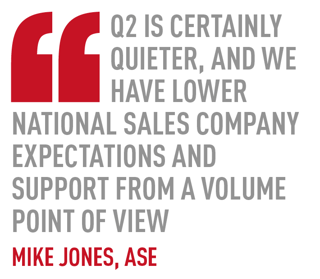The average UK car dealer produced a marginal profit of £600 per site in April, a significant drop from the prior year’s profit of £8,000.
This was to be expected and is a combination of the Easter holiday falling in April and a small pull-forward of new vehicle sales into March as a result of the changes to the VED regulations.
“But mainly it was the result of brands taking the foot off the gas a little bit with regard to the overall level of vehicles they were looking for dealers to do,” said Mike Jones (pictured), chairman at dealer performance improvement specialists ASE. “This resulted in lower levels of fast start, self-registrations at the end of the month- and lower dealer bonuses.”
The 20% drop in new vehicle registrations in April was matched by the same drop in new vehicle sales for the average retailer.
“This contrasts with used vehicle sales, which were up 40% compared to the prior year. Some of these sales are clearly substitutional, with pre-registered vehicles being sold as used cars bolstering those sales statistics and depressing new vehicle sales.
“Despite an increase in stock levels as December self registrations become available for sale, used vehicle return on investment has remained steady.
“I will naturally be watching over the coming months to see inventory levels fall back to seasonal norms, however there is every indication at the moment that this will be managed successfully by the retail motor sector.”
Aftersales continues to improve slowly on the back of the increasing vehicle parc.
ASE is concerned about the fall in the retail labour percentage, which is approaching 50%.
“Subject to a conclusive outcome in the general election, it looks like Q2 will be steady, but quiet on the back of lower manufacturer expectations, with a pickup as we move to the third quarter as brands reassess the levels of registrations they are looking for from dealers and we see a general pick-up in retail demand.”
> Franchised dealer performance data
ASE commentary video





















Jon Stone - 08/06/2017 13:30
Doesn't the fact he is saying manufacturer expectations lead to smaller dealer profits say a lot in itself - 'resulting in lower level of self registrations'. So what you are saying is that the market is indeed over inflated and false, and profit cannot be made (on average) without self registrations? a broken model.